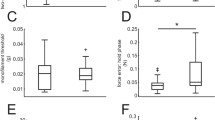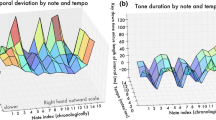Abstract
In the process of acquiring musical skills, such as playing the piano, we develop sensorimotor associations between motor movements and perception of pitch. Previous research suggests that these acquired associations are relatively inflexible and show limited generalizability to performance under novel conditions. The current study investigated whether piano training constrains the ability to generalize learning based on an unfamiliar (inverted) pitch mapping, using a transfer-of-training paradigm (Palmer and Meyer in Psychol Sci 11:63–68, 2000). Pianists and non-pianists learned a training melody by ear with normal (higher pitches to the right) or inverted (higher pitches to the left) pitch mapping. After training, participants completed a generalization test in which they listened to and then immediately reproduced four types of melodies that varied in their similarity to the melody used during training and were based on the same, a similar, an inverted, or a different pitch pattern. The feedback mapping during the generalization test matched training. Overall, pianists produced fewer errors and required fewer training trials than non-pianists. However, benefits of training were absent for pianists who trained with inverted feedback when they attempted to reproduce a melody with a different structure than the melody used for training. This suggests that piano experience may constrain one’s ability to generalize learning that is based on novel sensorimotor associations.





Similar content being viewed by others
Notes
It is worth noting that non-musicians in Western cultures typically report explicit knowledge about the mapping of pitch to piano keys. Our focus is not on this kind of explicit awareness, but instead on more implicit features of sensorimotor associations.
In Pfordresher & Chow (2019) only one successful trial was needed to progress. However, that study was limited by a high attrition rate (only 45% of recruited participants could complete the procedure). We reasoned that more repetitions of each progressive melody would facilitate memory consolidation. In support of this prediction, participant retention was much higher in this study (77%).
The pattern of results reported here remained the same when Log-transforming these data to better approximate a normal distribution.
The pattern of results reported here remained the same when analyzing the arc-sine square root transform of the data, yielding a closer approximation to the normal distribution.
References
Bangert, M., & Altenmüller, E. O. (2003). Mapping perception to action in piano practice: A longitudinal DC-EEG study. BMC Neuroscience, 4, 26.
Cohen, A., Ivry, R. B., & Keele, S. W. (1990). Attention and structure in sequence learning. Journal of Experimental Psychology: Learning, Memory, and Cognition, 16, 17–30.
Drost, U. C., Rieger, M., & Prinz, W. (2007). Instrument specificity in experienced musicians. Quarterly Journal of Experimental Psychology, 60, 527–533.
Herholz, S. C., & Zatorre, R. J. (2012). Musical training as a framework for brain plasticity: Behavior, Function, and Structure. Neuron, 76, 486–502.
Keller, P. E., & Koch, I. (2008). Action planning in sequential skills: Relations to music performance. The Quarterly Journal of Experimental Psychology, 61, 275–291.
Lahav, A., Saltzman, E., & Schlaug, G. (2007). Action representation of sound: Audiomotor recognition network while listening to newly acquired actions. The Journal of Neuroscience, 27, 308–314.
Lidji, P., Kolinsky, R., Lochy, A., & Morais, J. (2007). Spatial associations for musical stimuli: A piano in the head? Journal of Experimental Psychology: Human Perception and Performance, 33, 1189–1207.
MacKay, D. G., & Bowman, R. W. J. (1969). On producing the meaning in sentences. The American Journal of Psychology, 82, 23–39.
Meyer, R. K., & Palmer, C. (2003). Temporal and motor transfer in music performance. Music Perception, 21, 81–104.
Mishra, J. (2002). A qualitative analysis of strategies employed in efficient and inefficient memorization. Bulletin of the Council for Research in Music Education, 152, 74–86.
Novembre, G., & Keller, P. E. (2014). A conceptual review on action-perception coupling in the musicians’ brain: what is it good for? Frontiers in Human Neuroscience, 8, 603.
Palmer, C., & Meyer, R. K. (2000). Conceptual and motor learning in music performance. Psychological Science, 11, 63–68.
Palmer, C., & Pfordresher, P. Q. (2003). Incremental planning in sequence production. Psychological Review, 110, 683–712.
Penhune, V. B. (2011). Sensitive periods in human development: Evidence from musical training. Cortex, 47, 1126–1137.
Pfordresher, P. Q. (2005). Auditory feedback in music performance: The role of melodic structure and musical skill. Journal of Experimental Psychology: Human Perception and Performance, 31, 1331–1345.
Pfordresher, P. Q. (2012). Musical training and the role of auditory feedback during performance. Annals of the New York Academy of Sciences, 1252, 171–178.
Pfordresher, P. Q. (2019). Sound and action in music performance. San Diego, CA: Academic Press.
Pfordresher, P. Q., & Chow, K. (2019). A cost of musical training? Sensorimotor flexibility in musical sequence learning. Psychonomic Bulletin & Review, 26, 967–973.
Poggio, T., & Bizzi, E. (2004). Generalization in vision and motor control. Nature, 431, 768–774.
Prince, J. B., Stevens, C. J., Jones, M. R., & Tillmann, B. (2018). Learning of pitch and time structures in an artificial grammar setting. Journal of Experimental Psychology: Learning, Memory, and Cognition, 44, 1201–1214.
Rusconi, E., Kwan, B., Giordano, B. L., Umilta, C., & Butterworth, B. (2006). Spatial representation of pitch height: the SMARC effect. Cognition, 99, 113–129.
Schmidt, R. A., & Lee, T. D. (1999). Motor control and learning: A behavioral emphasis (3rd ed.). Champaign, IL: Human Kinetics.
Schultz, B. G., Stevens, C. J., Keller, P. E., & Tillmann, B. (2013). The implicit learning of metrical and nonmetrical temporal patterns. Quarterly Journal of Experimental Psychology, 66, 360–380.
Shibata, K., Sasaki, Y., Bang, J. W., Walsh, E. G., Machizawa, M. G., Tamaki, M., . . . Watanabe, T. (2017). Overlearning hyperstabilizes a skill by rapidly making neurochemical processing inhibitory-dominant. Nature Neuroscience, 20, 470-475.
Taylor, J. E., & Witt, J. K. (2015). Listening to music primes space: pianists, but not novices, simulate heard actions. Psychological Research Psychologische Forschung, 79, 175–182.
Tillmann, B., Bharucha, J. J., & Bigand, E. (2000). Implicit learning of tonality: A self-organizing approach. Psychological Review, 107, 885–913.
Zatorre, R. J., Chen, J. L., & Penhune, V. B. (2007). When the brain plays music: Auditory-motor interactions in music perception and production. Nature Reviews Neuroscience, 8, 547–558.
Zhang, J. D., Susino, M., McPherson, G. E., & Schubert, E. (2020). The definition of a musician in music psychology: A literature review and the six-year rule. Psychology of Music, 48, 389–409.
Finney, S. A. (2001). FTAP: A Linux-based program for tapping and music experiments. Behavior Research Methods Instruments & Computers, 33, 65–72.
Author information
Authors and Affiliations
Corresponding author
Ethics declarations
Conflict of interest
The authors declare no conflicts of interest.
Ethical standards
All procedures performed in studies involving human participants were in accordance with the ethical standards of the institutional and/or national research committee and with the 1964 Helsinki declaration and its later amendments or comparable ethical standards. Informed consent was obtained from all individual participants included in the study.
Additional information
Publisher's Note
Springer Nature remains neutral with regard to jurisdictional claims in published maps and institutional affiliations.
Rights and permissions
About this article
Cite this article
Pfordresher, P.Q., Honda, C., Greenspon, E. et al. Generalization of novel sensorimotor associations among pianists and non-pianists: more evidence that musical training effects are constrained. Psychological Research 85, 1934–1942 (2021). https://doi.org/10.1007/s00426-020-01362-9
Received:
Accepted:
Published:
Issue Date:
DOI: https://doi.org/10.1007/s00426-020-01362-9




